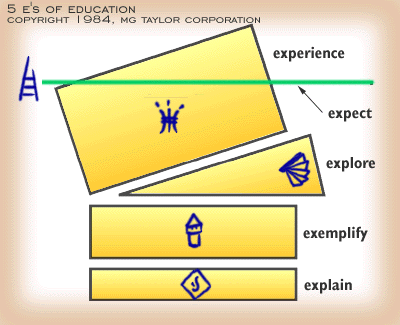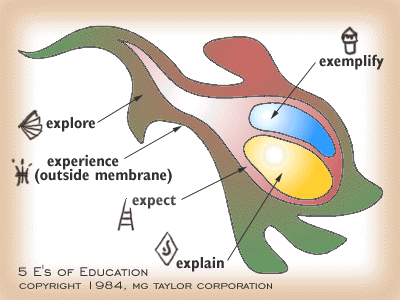|
|
 |
Modeling Language Spotlight
5
E's of Education Model
November 4, 1996 |
Here's a traditional look at the model:

click here to see the etymology
of the glyphs
The model reads like this: Explanations and examples form the
foundation of education, tying current models and knowledge bases into new ones.
Experience--the actual doing--raises the learner up to the level of expectation.
What leverages experience above expectation is the wedge of exploration, searching
the unknown, encountering the unexpected, uncovering the surprise.
Exemplification and Example
The second stage, exemplify, requires a bit more explanation (and
maybe an example or two :-). At its simplest level, this stage can be retitled,
"example." This falls in line with some standard thinking in education.
If we're going to be learning about the classification of minerals, some introductory
remarks on mineralogy may be appropriate, including the 14 types of crystal
lattices and the 32 crystal classes. It would then be appropriate to see some
examples of each type of lattice, as macroscopic crystals, and in thin sections
under the microscope.
The word "exemplify" was chosen instead of "example"
to remind mentors and facilitators in the education process that to some degree
they are the subject they teach--that they are examples of the spirit of the
subject. I remember a teacher who so loved mathematics that he would stand on
his desk in moments of enthusiasm and walk about the room from desktop to desktop,
completely animated by the subject. It was hard not to be caught up in that
same fever. Curiosity and affection enabled many of us in the class to push
through what was for us very difficult material. You exemplify what you love.
Mastering the spirit of the material is as critical as mastering the mechanics.
The Process of the 5 E's
As already noted, the model implies that explanations and examples
form the foundation of education, but this doesn't mean that they necessarily
come first in the process of education. Perhaps exploration and some experience
come first--then out of the experience the learner can extract explanations
and develop a systematic approach to hunt for further examples to confirm, deny,
or expand their conclusions. The clear explanation, in a way, is the LAST step
in the process. Only a master of a concept can explain it. Only a master has
the experience and exploration behind her to do so.
In practice, the process tends to jumble all of the 5 E's together,
calling upon whichever one is required by the learner to take the next step
or receive the next insight. When designing with the 5 E's, employ them as a
reference rather than as a rigid template. If an event lacks one or several
of the E's chances are its benefits will be marginalized. In isolation, exploration
is bewildering, experience fatal, expectation disappointed, explanation confusing,
and example unenlightening. Woven together, there is a possibility of synergy.
Another Diagram of the Model
A more fluid version of the model is shown below. In it, the explanation
and example form the core. They are surrounded by a sac and membrane of expectation.
Beyond that lies another, larger area of exploration. The membrane surrounding
the entire model is experience.

It's clear that expectations exceed simple explanation and example.
But they also, clearly must fall short of exploration, with it's hidden element
of the unknown and undiscovered. One of the keys to understanding this model
is to realize that experience enfolds it all. Even the act of hearing or reading
an explanation is an experience. If you imagine experience to be a separate
exercise from explanation, then the setting and force of the explanations will
likely suffer.
And experience should be crafted.
Experience should be managed using the Seven Domains as a template, for all experiences are facilitated
one way or another. Frequently the facilitative aspects are left to chance,
or hidden or poorly designed, but they are present.
Thus, we can couch experience in terms of the other four E's,
with the following result:
-
the experience of explanation is in the ability to listen,
focus and absorb (not necessarily referring to only an auditory process).
-
the experience of example is recognizing the pattern.
-
the experience of expectation is acknowledging mastery and
the path to be taken.
-
the experience of exploration is a sense of wonder and a willingness
to risk.
-
the experience of experience... (any philosophers out there?)
 |
Journal Assignment: All of the models
in the modeling language benefit and become stronger when their different
elements are examined from the context of each other. To acquire greater
understanding of the models, try asking yourself questions like these:
- what is the expectation of experience?
- how are Body of Knowledge (from the Seven Domains)
and exploration related?
- how are Scan, Focus, Act related to the 5 E's?
- what are the Technical Systems (from the Seven Domains model) associated
with example?
|
 
copyright © 1996, MG Taylor Corporation.
All rights reserved
copyrights,
terms and conditions
19961104162832.web.bsc
|















